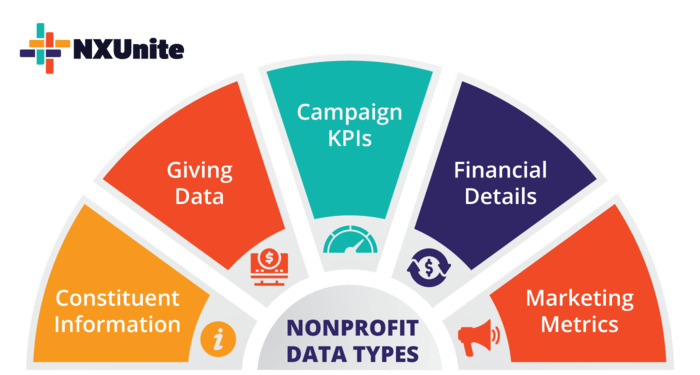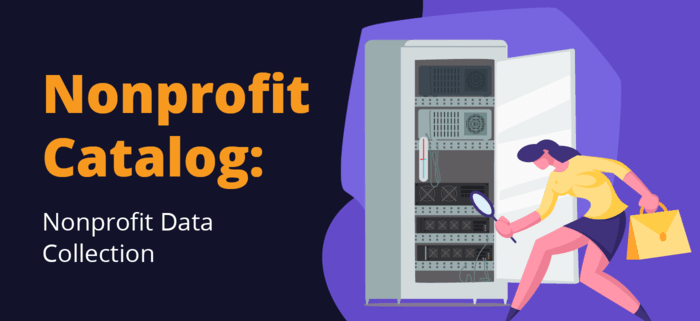Nonprofit Data Collection — Nonprofit Catalog
Regardless of whether you’re actively tracking it, data is attached to every action your nonprofit takes. From serving your beneficiaries to communicating with donors, metrics indicate performance and help you make informed decisions about increasing your impact. Without a nonprofit data collection plan, you’re missing out on important information about your work.
As part of your plan, you need to know what data your nonprofit will collect and how you’ll use it to guide your strategies. Let’s cover the basics, so you can start tracking your organization’s performance.
What Is Nonprofit Data Collection?
Nonprofit data collection is the process of gathering data to use in decision-making and strategic planning. It involves pulling data from various sources, like donation forms, marketing platforms, and fundraising campaign management tools.
Tracking and managing various types of data allows nonprofits to quantify the impact of their work. Effective collection strategies allow these organizations to make educated decisions about improving their programs, strengthening their marketing, and amplifying their mission as a whole.
What Data Should Nonprofits Collect?
From fundraising and marketing to community outcomes, the metrics your nonprofit can monitor are endless. However, just because you can collect all this data doesn’t mean you should. Too many metrics will clutter your database, and you’ll have to muddle through the unnecessary data points to get to the ones that are actually helpful.
NPOInfo’s guide to nonprofit data collection breaks common metrics down into several different crucial categories. These categories will give you a solid foundation for shaping your nonprofit’s data collection process.

1. Constituent Information
Between donors, volunteers, and advocates, your nonprofit interacts with a lot of supporters. Supporter data lets you know exactly who these individuals are, so you can cater your outreach and work to appeal to them.
Start by collecting basic personal information like the following:
- Name: This will allow you to address individuals by their preferred names and titles.
- Age: Tracking this means you can send relevant appeals and gain insight into the best ways to contact your supporters. For example, younger audiences may respond better to social media or SMS outreach, while older audiences may engage more with direct mail solicitations.
- Employment status and employer: Tap into corporate giving, such as volunteer grants or matching gifts, by understanding individuals’ employer information.
- Contact details and preferences: Collect supporters’ email addresses, phone numbers, and postal addresses. Knowing their contact information and preferred methods of communication will allow you to keep in touch.
If any of this information is missing from your CRM, look into conducting a data append. Our data append guide explains that this process enables you to “pull data from external sources to correct incorrect data or supplement incomplete data.” Most often, data append service providers will append contact information, birthdays, and employment details.
2. Giving Data
From here, you can dig deeper into supporters’ giving tendencies, directly deepening your understanding of their motivations. You might track details like:
- Type of supporter: Mark individuals as donors, volunteers, event attendees, advocates, and so on. That way, you can reach out with relevant opportunities.
- Giving amount and frequency: Segment them even further by monitoring how frequently and how much they give, whether they donated, volunteered, or supported your work in some other way once or on a recurring basis.
Tracking these details will enable you to reach out with the right appeals at the right times, increasing the likelihood that someone will continue giving to your cause.
3. Campaign Data
You spend time planning and executing your campaigns. Don’t let that go to waste by overlooking your performance metrics. Campaigns provide a prime opportunity to collect data, such as:
- Event attendance: Track how many people attend your events. Doing so will let you know which types of events appeal to the widest audiences possible.
- Revenue: Monitor how much your campaigns raise and the sources of those contributions, whether they’re donations, matching gifts, or sponsorship money.
- Campaign conversions: Track how many first-time donors, volunteers, newsletter subscribers, and so on that your campaign acquires.
- Donor and volunteer retention rates: Retention rates indicate the success of your supporter engagement efforts. Measure donor and volunteer retention across your campaigns to determine what inspires people to stay involved.
Collecting data for your nonprofit’s campaigns will help you revise your approach and make the most of future campaigns. Start with these key performance indicators and build out your list from there.
4. Financial Data
Most nonprofits operate on limited budgets. That means every dollar matters. To maximize revenue and cover operating expenses, you’ll need to collect financial data such as:
- Income: Track the revenue you receive through donations, membership fees, products, sponsorships, and so on. This will also allow you to project growth targets.
- Expenses: Your nonprofit needs to spend the money it raises to pursue its mission. Track how much you spend on staff salaries, campaign costs, vendor charges, and any other day-to-day operating costs.
- Cash-on-hand: This is the total amount of money that’s accessible at any given moment. Between bank accounts and additional assets, track your reserve funds to know how long your nonprofit can feasibly last without additional income.
- Investments: If your nonprofit invests its funds, keep up with how much you’ve invested in different sources, and record investment income at the end of each month.
Tracking this data will allow you to monitor cash flow, remain financially stable, and plan future budgets.
5. Marketing Metrics
External communication is vital for acquiring new supporters and retaining existing ones. When sending solicitations and marketing your programs, make sure you have nonprofit data collection processes in place to pinpoint the most effective communication strategies.
Here are some of the most important marketing metrics your nonprofit should collect, broken down into different categories:
- Email metrics: Email has the highest ROI of any marketing platform. To maximize its potential, Feathr’s nonprofit email marketing guide recommends using your email software to monitor your open rate, click-through rate, conversion rate, and unsubscribe rate.
- Ad performance: If you invest in paid advertising like Microsoft Ads or Google Ads, use each platform’s ad interface to collect data like your click-through rate, conversions, bid spending, and impressions.
- Website KPIs: Data can help your nonprofit indicate which content is the most popular, determine content strategies, and improve the user experience. Track metrics like your traffic sources, bounce rate, and click-through rates.
- Social media amplification: From Instagram to TikTok, collect metrics such as likes, comments, impressions, and shares to determine which platforms and types of messages perform well.
In a data-driven world, nonprofit data collection is a must for any organization that wants to thrive. Chances are, your nonprofit already collects most of the data we mentioned above. Now, it’s a matter of what you do with your data that matters!
Once you determine what metrics you’ll track, strengthen your nonprofit data collection and management strategies by streamlining forms to capture these details and practicing data hygiene to keep everything in order.
Additional Resources
Nonprofit Catalog – Read up on more nonprofit essentials by exploring our Nonprofit Catalog.
Donor Data Management: A Quick Guide for Nonprofits – Need inspiration for leveraging the data your nonprofit has collected? Explore this guide to learn how to put your data to use.
Nonprofit Fundraising Metrics: 32 KPIs To Measure Success – There are countless metrics your nonprofit can collect. Check out this extensive list to learn more about what data you should collect.


